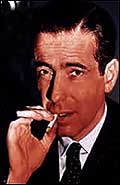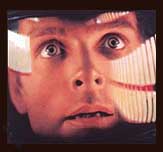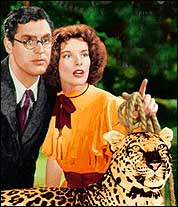Though we might think
of film as an essentially visual experience, we really cannot afford
to underestimate the importance of film sound. A meaningful sound
track is often as complicated as the
image on the screen. The entire sound track is comprised of three
essential ingredients:
- the human voice
- sound effects
- music
These three tracks
must be mixed and balanced so as to produce the necessary emphases
which in turn create desired effects. Topics which essentially refer
to the three previously mentioned tracks are discussed below. They
include dialogue, synchronous and asynchronous sound, and music.
THE
HUMAN VOICE: dialogue
Dialogue
authenticates the speaker as an individual or a real person
rather than the imaginary creation of a story teller. As is the
case with stage drama, dialogue serves to tell the story and
expresses feelings and motivations of characters as well. Often
with film characterization the audience perceives little or no
difference between the character and the actor.
 Thus,
for example: Thus,
for example:
Humphrey Bogart is Sam Spade; film personality and life personality
seem to merge. Perhaps this is the case because the very texture
of a performer's voice supplies an element of character.
When voice texture
fits the performer's physiognomy and gestures, a whole
and very realistic persona emerges. The viewer sees not an actor
working at his craft, but another human being struggling with
life. It is interesting to note that how dialogue is used and
the very amount of dialogue used varies widely among films.  For
example: For
example:
In the film 2001
little dialogue was evident, and most of what was used was banal.
In this way the filmmaker was able to portray the “inadequacy
of human esponses when compared with the magnificent technology
created by man] and the visual beauties of the universe.”[2]
 The
comedy, Bringing
Up Baby, on the other hand, presents practically non-stop
dialogue delivered at break-neck speed. This use of dialogue underscores
not only the dizzy quality of the character played by Katharine
Hepburn, but also the absurd duality of the film itself and thus
its humor. The audience is bounced from gag to gag and conversation
to conversation; there is no time for audience reflection. The
audience is caught up in a whirlwind of activity in simply managing
to follow the plot. This film presents pure escapism - largely
due to its frenetic dialogue. The
comedy, Bringing
Up Baby, on the other hand, presents practically non-stop
dialogue delivered at break-neck speed. This use of dialogue underscores
not only the dizzy quality of the character played by Katharine
Hepburn, but also the absurd duality of the film itself and thus
its humor. The audience is bounced from gag to gag and conversation
to conversation; there is no time for audience reflection. The
audience is caught up in a whirlwind of activity in simply managing
to follow the plot. This film presents pure escapism - largely
due to its frenetic dialogue.
SOUND
EFFECTS: synchronous and asynchronous sounds
Synchronous
sounds are those sounds which are synchronized or matched
with what is viewed. For
example:
 If
the film portrays a character playing the piano, the sounds of
the piano are projected. If
the film portrays a character playing the piano, the sounds of
the piano are projected.
Synchronous sounds
contribute to the realism of film and also help to create
a particular atmosphere. For
example:
 The “click” of a door being opened may simply serve to convince
the audience that the image portrayed is real, and the audience-may
only subconsciously note the expected sound. However, if the “click”
of an opening door is part of an ominous action such as a burglary,
the sound mixer may call attention to the “click” with an increase
in volume; this helps to engage the audience in a moment
of suspense.
The “click” of a door being opened may simply serve to convince
the audience that the image portrayed is real, and the audience-may
only subconsciously note the expected sound. However, if the “click”
of an opening door is part of an ominous action such as a burglary,
the sound mixer may call attention to the “click” with an increase
in volume; this helps to engage the audience in a moment
of suspense.
Asynchronous sound
effects are not matched with a visible source of the sound
on screen. Such sounds are included so as to provide an appropriate
emotional nuance, and they may also add to the realism of the
film.  For example:
For example:
A film maker might opt to include the background sound of
an ambulance's siren while the foreground sound and image portrays
an arguing couple. The asynchronous ambulance siren underscores
the psychic injury incurred in the argument; at the same time
the noise of the siren adds to the realism of the film by acknowledging
the film's (avowed) city setting.
MUSIC:
background
music
Background music
is used to add emotion and rhythm to a film. Usually not meant
to be noticeable, it often provides a tone or an emotional attitude
toward the story and/or the characters epicted. In addition,
background music often foreshadows a change in mood. For example,
dissonant music may be used in film to indicate an approaching
(but not yet visible) menace or disaster.
Background music
may aid viewer understanding by linking scenes. For example,
a particular musical theme associated with an individual
character or situation may be repeated at various points in a
film in order to remind the audience of salient motifs or ideas.
Film sound is comprised
of conventions and innovations. We have come to expect an acceleration
of music during car chases and creaky doors in horror films. Yet,
it is important to note as well that sound is often brilliantly
conceived. The
effects of sound are often largely subtle and often are noted
by only our subconscious minds. Yet, it behooves us to foster
an awareness of film sound as well as film space so as to truly
appreciate a twentieth century art form, the modern film.
2. Thomas Sobochack
and Vivian Sobochack, An Introduction to Film, p.177.
This is
an excerpt from America in Film and Fiction
original URL: http://130.132.143.21/ynhti/curriculum/units/1988/4/88.04.04.x.html
This article
is a condensed version of several chapters of Sobochack and Sobochack's
book, An Introduction to Film. The original web site also contains
a section about film space.
 FilmSound.org
www.filmsound.org
FilmSound.org
www.filmsound.org
Oxford University: "...an excellent collection of resources
and links.." |
|